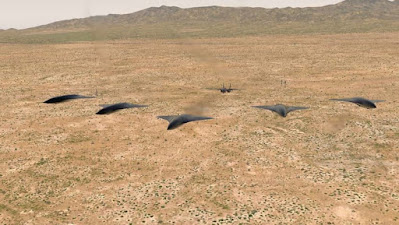Arrow Supersonic UCAV (image : CNA)
Singapore's Ministry of Defense is pushing ahead with plans to build supersonic unmanned aerial vehicles (UAVs) with many formidable combat features. With the ambition to create supersonic UAVs that can carry bombs, leading fighters in battles. This plan is being actively researched and invested by Kelley Aerospace Corporation.
By design, Singapore's UAVs are capable of striking important targets, with lightning speed that makes the enemy unable to react. Meanwhile, some other UAVs will be used as decoys for defense systems to protect the fighters behind to destroy enemy targets.
According to a source from Channel NewsAsia, Kelley Aerospace Corporation has launched a UAV called Arrow, this combat UAV model is made of carbon fiber with a design that can fly at Mach 2.1 (2.1 times the speed of sound), equivalent to 2,572 km/h.
Kelley Aerospace says the Arrow, seen in this artist's impression, can fly at speeds of up to Mach 2.1, or 2,572km/h (image : Kelley Aerospace)
The Arrow UAV is painted black 14m long, has a wingspan of 9m, and looks like an alien spaceship. Singapore's defense officials said the Arrow was built to order, for use in air-to-air combat, air-to-ground combat, reconnaissance as well as search and rescue.
Arrow can take off automatically and can be controlled remotely by two people on the ground or from a manned aircraft. The Arrow UAV is designed to accompany manned aircraft during mission deployment, can be used as bait for surface-to-air missiles, fight with fighters, infect communications and radars, search and destroy targets, target or enemy surface-to-air missiles.
Arrow can carry missiles and external fuel tanks, as well as navigation or electronic warfare devices. The aircraft has a take-off weight of up to 16,800 kg and can fly more than 4,000 km without refueling.
Each Arrow UAV is expected to cost between $9-16 million, depending on the application, this is considered "pretty low" and the company has pre-ordered 100 units. Kelley Aerospace said the program attracted great interest with offers from many other countries.
Development of the Arrow began in 2012, and the company flew the first UAV two years later in Israel with a miniaturized version measuring just 4 meters long, with better-than-expected results.
The company plans to test the full-size Arrow in four countries over the next month to see how the drone can handle high speeds, heavy payloads, and control from the ground.
The goal of the engineers is to test four Arrows that will launch simultaneously in the US, Australia, Israel, and the Czech Republic "with the push of a button" in Singapore, before letting them operate according to the program.
However, experts say there are still many challenges in turning Arrow's theoretical capabilities into reality. Expert Chen Chuanren, of Aviation Week magazine, said that the triangle wings are not aerodynamically stable, so a very powerful computer is needed to control them when flying.
An illustration of how multiple Arrows could fly in sync with a fighter jet (image : Kelley Aerospace)
Similarly, expert Mike Yeo of Defense News Asia commented that this software must react much faster than devices flying at subsonic speeds. Therefore, this is indeed a major technical barrier to overcome.
Arrow's computer would have to sync with other manned aircraft. Kelley Aerospace experts said that an F-16 fighter flying behind commanded about 18-20 UAVs in front, this fighter would be very safe.
The process of injecting resin into moulded carbon fibre (image : Kelley Aerospace)
The production of Arrow will require high-quality materials and the most modern technology, so the production cost will be very expensive. However, this program is completely self-financed and has no capital from the government or investors. Besides, this UAV program is not for war but was created for the purpose of preventing war.
The unibody design gives Arrow outstanding strength and rigidity. The Arrows' maximum weight is 16.8 tons (about half that of the F-35 Lightning II. Arrows are designed to reduce radar cross-section, apply materials and apply technology to reduce infrared signals to combine with manned aircraft.
(DatViet)





